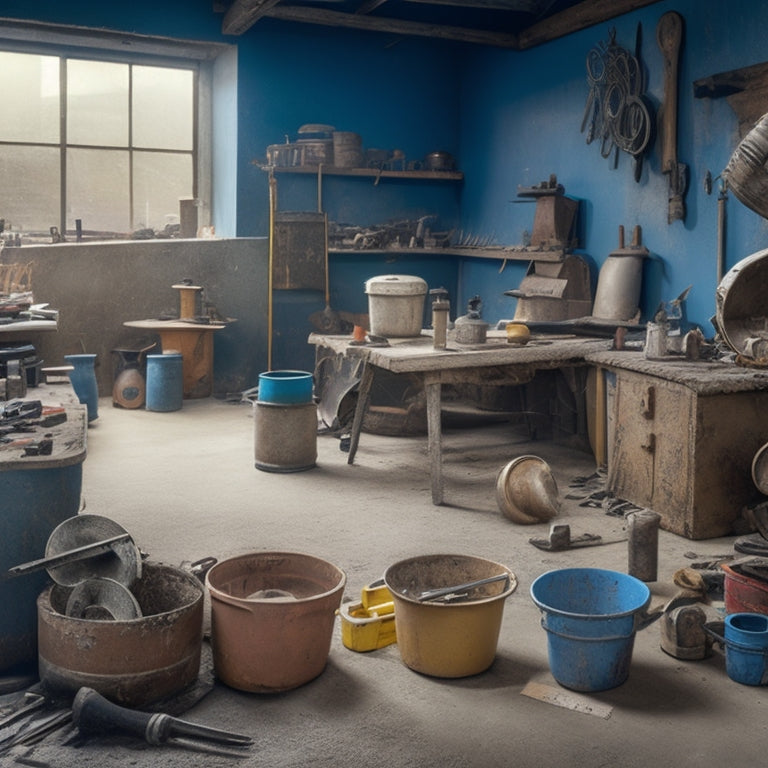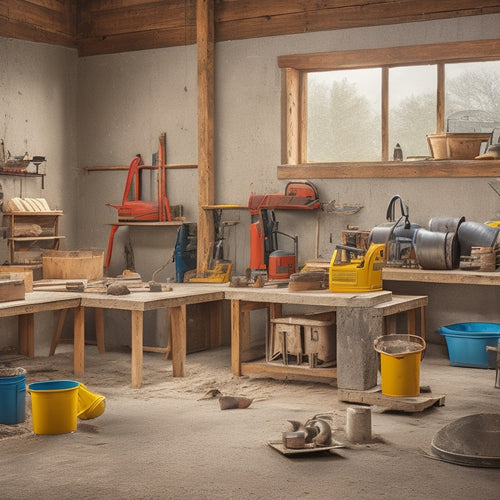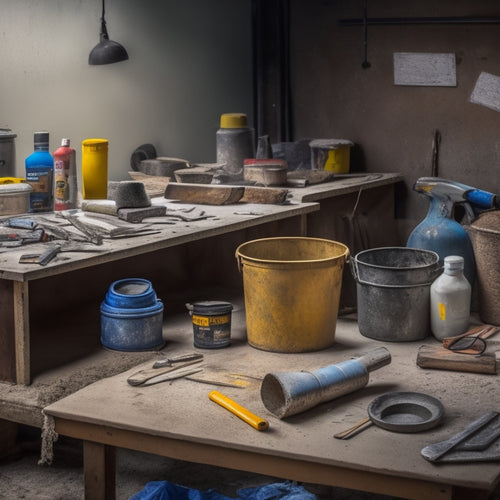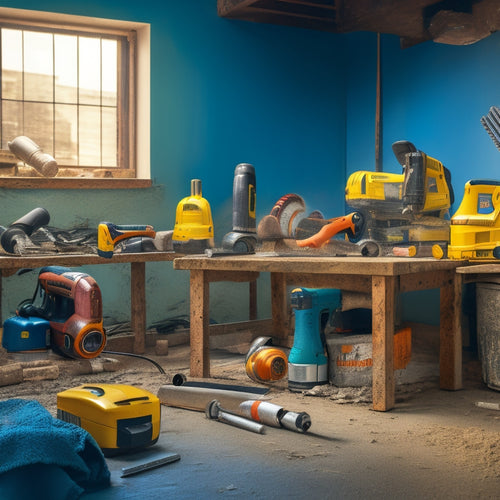
Best Tools for Concrete Restoration and Repair
Share
When tackling concrete restoration and repair projects, you need a range of reliable tools to achieve professional-grade results. A high-quality concrete mixer, scarifier/grinder, and trowel/edger are essentials for any job. For floor repair, a high-torque drill, diamond-tipped bits, and self-leveling compound are must-haves. Grinders, scarifiers, and specialty finishing tools like power trowels and stamps/stencils also play critical roles. Invest in durable, heavy-duty equipment and prioritize regular maintenance to guarantee peak performance. With the right tools and knowledge, you'll be well-equipped to handle complex concrete projects - and there's more to explore about each of these tools to take your skills to the next level.
Key Takeaways
• High-quality concrete mixers are essential for handling heavy loads and maintaining consistent mixes for strong, durable concrete.
• Scarifiers and grinders are vital for removing old coatings, roughening surfaces, and creating strong bonds for successful concrete restoration projects.
• Adjustable mixing paddles and reliable trowels and edgers ensure customization of mix consistency and precise finishing and detailing of concrete surfaces.
• Specialty tools like power trowels, handheld trowels, and concrete floats are necessary for efficient finishing, smoothing surfaces, and removing imperfections.
• Personal protective equipment, dust collection systems, and reliable braking systems are crucial for ensuring safety during concrete restoration and repair projects.
Top Rated Tools for Concrete
What're the essential tools you need to get the job done when working with concrete, and which ones stand out from the rest as top-rated for their performance and durability?
When it comes to concrete restoration, having the right tools can make all the difference.
For concrete mixing, you'll need a high-quality mixer that can handle heavy loads and maintain a consistent mix. Look for one with a sturdy frame, robust motor, and adjustable mixing paddles.
For surface preparation, a concrete scarifier or grinder is a must-have. These tools help remove old coatings, roughen the surface, and create a strong bond between the old and new concrete. Top-rated options feature heavy-duty construction, adjustable handlebars, and efficient dust collection systems.
Additionally, a reliable trowel and edger are essential for finishing and detailing the concrete surface.
Essential Equipment for Floor Repair
Essential Equipment for Floor Repair
When tackling floor repair, you'll need to equip yourself with specialized equipment to guarantee a successful outcome, starting with a high-torque drill and a set of diamond-tipped bits for efficient hole drilling and anchor placement. Additionally, a concrete mixer and a bucket of self-leveling compound will come in handy for floor leveling and surface preparation.
| Equipment | Purpose |
|---|---|
| High-torque drill | Efficient hole drilling and anchor placement |
| Diamond-tipped bits | Precise drilling and reduced wear |
| Concrete mixer | Mixing self-leveling compound for floor leveling |
| Self-leveling compound | Filling gaps and uneven surfaces |
These essential tools will help you achieve a smooth, even surface, ensuring a successful floor repair. Remember to also invest in personal protective equipment, such as gloves and safety glasses, to protect yourself from potential hazards. By having the right equipment, you'll be well-prepared to tackle any floor repair project that comes your way.
Best Grinders for Concrete Floors
You'll need a high-performance grinder to effectively remove old coatings, smooth out rough surfaces, and prepare your concrete floor for restoration.
When selecting a grinder, consider the type of concrete you're working with, as well as the desired finish. There are three main grinder types: walk-behind, ride-on, and handheld. Walk-behind grinders are ideal for large areas, while ride-on grinders provide increased productivity and comfort. Handheld grinders are perfect for smaller areas and tight spaces.
Safety features are essential when operating a grinder. Look for grinders with dust collection systems to minimize airborne particles. Additionally, make sure your grinder has a reliable braking system, adjustable handlebars, and a durable construction. Some grinders also come equipped with automatic shut-off, which prevents accidents in case of an emergency.
When choosing a grinder, consider the power output, disc size, and RPM. A higher power output and larger disc size can increase efficiency, but may also increase the risk of damage to the concrete. Aim for a grinder with a moderate power output and adjustable RPM to achieve the perfect balance between efficiency and control.
Effective Scarifiers for Cement Repair
After preparing your concrete floor with a high-performance grinder, it's time to tackle deeper imperfections and rough surfaces with an effective scarifier, a tool specifically designed to aggressively remove thick coatings, mastics, and deteriorated concrete.
You'll want to choose a scarifier that suits your project's needs, considering factors like drum size, blade type, and horsepower. For larger areas, a walk-behind scarifier may be ideal, while smaller, more precise jobs might call for a handheld model.
Regardless of the type, proper scarifier maintenance is vital to guarantee peak performance and extend the tool's lifespan. Regularly inspect and replace worn or damaged blades, and keep the machine clean to prevent dust and debris buildup.
Effective surface preparation is key to a successful concrete restoration project, and a well-maintained scarifier is essential to achieving a smooth, even finish. By selecting the right scarifier and following proper maintenance procedures, you'll be well on your way to achieving a high-quality concrete repair.
Specialty Tools for Concrete Finishing
With your concrete surface properly scarified, it's time to focus on achieving a high-gloss finish or specialized texture using specialty tools designed for concrete finishing.
Now, you'll need to perfect your trowel techniques to achieve the desired finish. A power trowel is ideal for large areas, while a handheld trowel provides more control for smaller spaces and intricate designs. For added texture, consider using a stamp or stencil to create unique patterns.
To add the finishing touches, you'll need a range of specialized tools. A concrete float is essential for smoothing out the surface and removing any imperfections. An edger is used to create clean, defined edges around drains, corners, and other areas where the concrete meets other materials.
Frequently Asked Questions
What Safety Gear Is Required for Concrete Restoration and Repair?
When working with concrete, you'll need to prioritize safety above all else.
You're required to follow strict safety protocols to minimize risks.
Start by investing in essential protective equipment, including steel-toed boots, gloves, safety glasses, and a dust mask.
Don't forget a hard hat and high-visibility vest for added protection.
Confirm you're properly trained on equipment operation and emergency procedures to avoid accidents.
Can I Rent Concrete Restoration Equipment Instead of Buying?
You're considering renting concrete restoration equipment instead of buying, which can be a cost-effective approach.
Rental equipment benefits include reduced upfront costs, minimized storage needs, and access to specialized tools without long-term commitment.
When comparing costs, calculate the total rental fees versus the purchase price, factoring in maintenance, storage, and potential equipment upgrades.
How Do I Properly Clean and Store Concrete Tools?
You're wrapping up a concrete restoration project, and now it's time to give your tools the TLC they deserve, just like a chef meticulously cleans their knives after a busy night.
To properly clean and store concrete tools, employ effective cleaning techniques, such as wire brushing and pressure washing, to remove stubborn debris.
Then, organize tool storage by categorizing and labeling each item, ensuring easy access and prolonging their lifespan.
What Are the Differences Between Concrete Repair and Replacement?
When deciding between concrete repair and replacement, you'll need to evaluate concrete durability factors, such as the structure's intended use, environmental conditions, and load-bearing capacity.
Compare the costs of each option, weighing the expense of repairing cracks and damage against the cost of removing and replacing the entire concrete structure.
Conduct a thorough cost comparison to determine which approach will provide the most value in the long run.
Can I DIY Concrete Restoration or Should I Hire a Pro?
You're wondering if you should take on concrete restoration yourself or bring in a pro. It's a valid question, considering the cost comparison and project timeline are significant factors.
While DIY enthusiasts might be tempted to tackle the job, concrete restoration requires specialized skills and equipment.
Unless you have extensive experience, hiring a professional will likely save you time and money in the long run, ensuring a high-quality finish that lasts.
Conclusion
As you've made it this far, you're now equipped with the ultimate toolkit for concrete restoration and repair.
But, the real challenge begins - mastering these tools to achieve flawless results.
Will you be able to harness the power of grinders, scarifiers, and specialty tools to transform cracked and worn-out concrete into a work of art?
The fate of your next project hangs in the balance.
The clock is ticking, and the concrete is waiting - get to work!
Related Posts
-

What Tools to Rent for a Concrete Home Reno
When tackling a concrete home renovation, you'll need to rent a variety of specialized tools to get the job done. For...
-

3 Best Tools to Buy for Concrete Repair Online
When buying tools for concrete repair online, you'll want to research multiple retailer options to find the best prod...
-

Essential Power Tools for Concrete Block Construction
When building with concrete blocks, you'll need a range of power tools to cut, drill, mix, and finish the blocks to g...


